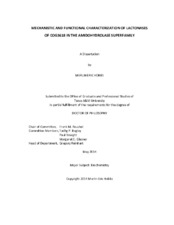| dc.description.abstract | The postgenomic era of scientific research has yielded an inundation of gene
and protein sequences which are available in public databases. This torrent of
sequences, literally in the millions, has altered the strategies, methodologies, and
approaches taken toward function discovery and annotation. At the forefront, are
interdisciplinary approaches; such as, genomic enzymology. Genomic enzymology
bridges aspects of classical enzymology, structural and functional genomics, and
comparative genomics. These methods also take advantage of evolutionarily related
proteins, which have relatively similar sequence similarity but, yield different functions.
The amidohydrolase superfamily (AHS), contains proteins of similar chemistry and
topology, which are related to one another through a common ancestral progenitor.
The AHS has been organized into smaller groups based only on sequence similarity,
which are known as clusters of orthologous groups (COG). There are currently 24 COGs
within this superfamily. Cog3618 is comprised of primarily lactonase enzymes.
The first identified member of cog3618 was LigI, which catalyzes the reversible
hydrolysis of 2-pyrone-4,6-dicarboxylate. The chemical mechanism was elucidated and
it was determined that this protein is the first member of the AHS that does not require
a metal cofactor for catalysis. The mechanistic characteristics of LigI, along with
genomic enzymology, were utilized to predicted and identify the functions of two other
COG members. BmulJ_04915 and BVU_0220 were identified as L-fucono-1,5-lactonase
and L-galactono-1,5-lactonase, respectively. NMR analysis revealed that these enzymes give preference to 6-member lactones, as opposed to their more stable counterparts. In addition, it is proposed that L-galactono-1,5-lactone participates in a novel L-galactose catabolic pathway, which appears to converge with D-galacturonate degradation through the intermediate of an adjacent dehydrogenase (BVU_0222). BVU_0222 was determined to oxidize L-galactonate to D-tagaturonate, which is a pathway intermediate for the degradation of D-glucuronate. | en |


